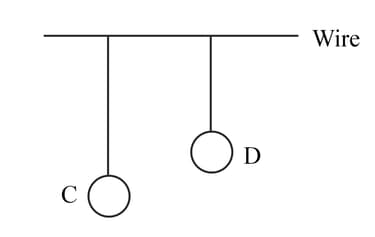Define forced oscillation.
Important Questions on Oscillations
A pendulum with the time period of is losing energy due to damping. At a certain time, its energy is . If after completing oscillations its energy has become , then its damping constant (in ) will be
(Assume and let is the density of the water)
The amplitude of a simple pendulum, oscillating in air with a small spherical bob, decreases from 10 cm to 8 cm in 40 seconds. Assuming that Stokes law is valid, and ratio of the coefficient of viscosity of air to that of carbon dioxide is 1.3, the time in which amplitude of this pendulum will reduce from 10 cm to 5 cm in carbondioxide will be close to (ln 5 = 1.601, ln 2 = 0.693).
Two pendulums and are suspended from a wire as shown in the given figure. Pendulum is made to oscillate by displacing it from its mean position. It is seen that also starts oscillating. Name the type of oscillation, will execute.

A vibration tuning fork is placed over the mouth of a burette filled with water. The tap is opened and the water level gradually falls. It is observed that the sound becomes the loudest for a particular length of air column.
Why does the sound become the loudest?

